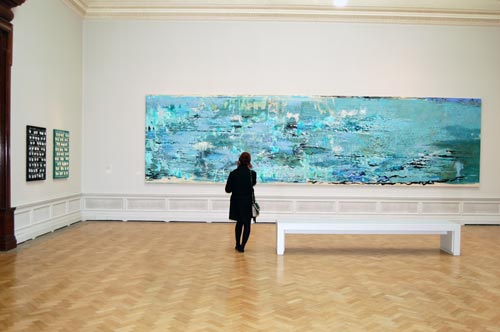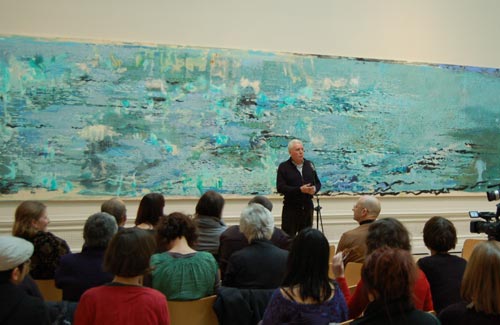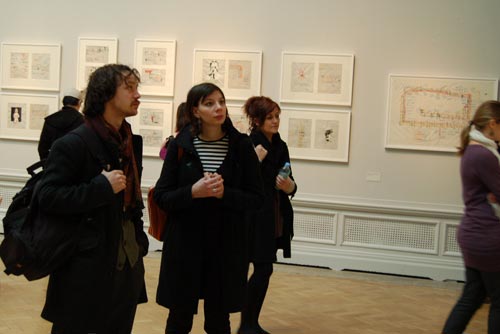Stephen Farthing’s Ultra Marine Painting
Tags: Avalanche, Chelsea Futurespace, Futurecity, Lisa Le Feuvre, Shelagh Cluett: Sculpture 1977 - 1980, Stephen Farthing, The Life Room

CHELSEA space Assistant Jo McGaffin emerses herself in Stephen Farthing's epic painting of the Atlantic Ocean
Stephen Farthing RA, artist, writer, and co-curator of The Life Room at CHELSEA space has opened a magnificent exhibition entitled The Back Story at the Royal Academy of Arts as part of their ‘Artists’ Laboratory’ series. The brilliant centrepiece of the exhibition is a 10m (30ft) long painting of the Atlantic Ocean entitled Painting The Atlantic which coincidently was commissioned by CHELSEA space Director Donald Smith for the inaugural exhibition at CHELSEA space’s sister gallery, Chelsea Futurespace.
On Tuesday 16th November, the CHELSEA space team headed down to the Royal Academy to hear Stephen Farthing talk about his work and his research. The ‘Artists Laboratory’ series, not unlike CHELSEA space, ”sets out to uncover aspects of the thinking and working processes behind making works of art and architecture”, Farthing was on good form and very generously gave us insights into his painting and thinking processes. Although there are common threads running throughout his work, Farthing tends to work in “projects” taking on a theme, an idea, or a pictorial painting problem. He probes his chosen subject making countless drawings, preparatory paintings, and finished artworks until he feels he has exhausted his line of enquiry and then moves on to a new “project”. He decribed this restless enquiry as a journey or long walk, never knowing what’s ahead and contrasted this with artists who repetitively rework a single idea, which he likened to living in a prison and being forced to constantly repaint the bars. In the exhibition he presents five “projects”.
When Stephen Farthing was approached by Donald Smith and Futurecity’s Mark Davy to make the inaugural exhibition at Chelsea Futurespace, he was working between his studio near the Thames at Millbank and his studio by the ocean on Long Island, New York and so he proposed a large painting depicting these two points and the vast expanse of water in between. The painting was started in New York and finished in London and had the working title Thames and Hudson. In the event he realised that both rivers flowed into the sea from west to east and gradually he dispensed with any idea of land mass or nautical architecture and instead concentrated on the water itself. This vast painting was never preconcieved in its entirety through a single sketch overview, instead his preparatory works were a series of small works on paper and canvas each containing a single gestural mark that could be used as a vocabulary of watery forms throughout the painting. He likened these marks to Arabic script.
The catalogue essay for Stephen Farthing’s 2006 Chelsea Futurespace exhibition was written by Lisa Le Feuvre who curated the landmark Avalanche exhibition at CHELSEA space in 2005 and who was recently appointed Head of Sculpture Studies at The Henry Moore Institute. Le Feuvre, coincidently, also wrote the introduction for our current exhibition, Shelagh Cluett: Sculpture 1977-1980. Farthing’s publication for his Royal Academy exhibition is a well designed and useful book and includes an essay by David Scott Kastan, Professor of English at Yale University, and an artists’ interview between Stephen Farthing and Stephen Chambers.




